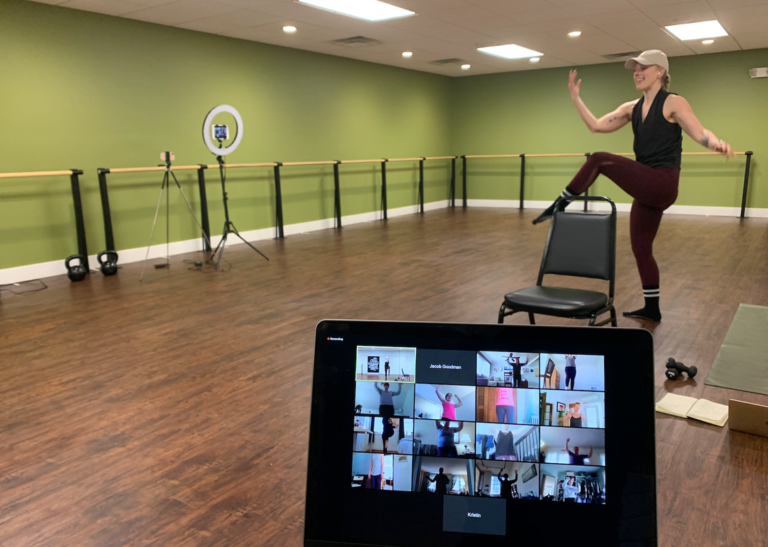Online training: There has been a lot of growth in online virtual personal training and fitness with COViD19 and the advancement of online real-time technology. Online training represents an opportunity for professionals to add another stream of income. It is a new way to deliver fitness, support, and accountability for personal training and fitness businesses.
Personal trainers who work with new technology rather than viewing it as a threat to their existence will benefit both their clients and their businesses. It is important to adapt to the changes, embrace what is now available and be aware of where it’s headed in the near future.
This article is a collection of tips to guide online training businesses. These are covered in more detail in our Online Trainer Short course.

-
Safety
The number one rule of training is: Do No Harm. Ensure clients are aware of what encompasses a safe environment to exercise within, for example, ensure that the exercise area is clear and free from obstructions or other potential hazards or risks – e.g. coffee table, pets.
-
Privacy
Maintain appropriate security policies and practices to safeguard sensitive and confidential information in privacy laws. Have a privacy policy and terms and conditions available on the website
-
Insurance
Hold the appropriate insurance coverage by ensuring that your policy covers online virtual training services within your scope of practice.
-
Great Relationships
Build great relationships and make people feel special, listened to, and valued. This is why people want to train with their personal trainers in the first place. Personal trainers and boutique fitness studios have established community, relationships, trust, real people having fun, and meaningful interaction. These are the things personal training clients love, and now is the time people need it the most. Embrace this new environment of social distancing and online training to make a positive difference.

-
Online Screening
Conduct pre-exercise screening, initial assessments, personalised programming, regular monitoring and reviews. In the absence of direct observation, identify when a client is not suitable for online exercise service delivery. This could be due to:
- The ability of the client – e.g. has never exercised before and therefore needs more direct supervision of exercise technique.
- The contraindications presented by the client – e.g. injuries/illness that require exercise adaptation and may need direct observation of the client’s exercise technique and/or intensity etc.
-
The Products
Know your products. There are many online options from training clients via online platforms like ZOOM; to ebooks; to online programs. Some are high yield options like online personal training; some are passive income like ebooks; some are regular payments like monthly plans.
-
Time Management
Prioritise the most important things and designate time in the week for support, emailing etc.
-
Quality
Commit to the customer’s satisfaction and manage expectations. Clearly, honestly, and accurately represent the services, products etc, with clear terms and conditions. Communicate precise instructions and guidance of what clients will receive.

-
Budget
Establish a budget. How much money is needed each month for the business to recoup the costs / make it worthwhile? What are the time requirements? Some people desire to be fully online and others simply want an addition to their existing PT Business / Gym.
-
Client Results
Help client get results. If the client wants to lose weight, help them lose weight. If the client wants to get fit, help them get fit.
Clients generally have three goals: They want to look better, feel better and perform better.
Each client has a different combination of goals, and not all clients care about all three. For example, a client who wants to look better might want to lose weight, gain weight, tone up or get a six pack. A client who wants to feel better might want to have more energy or notice improvements in mood. A client who wants to perform better might want to improve at a specific sport or be able to lift his or her kids.
-
Planning
Training a client online requires planning.
If a client has a pain in an in person personal training session, it can be handled as it happens. It’s more complicated online so take a proactive approach by anticipating any hiccups before they happen and plan these into the workout. It is important to know clients well and understand their contraindications to plan ahead.
-
Payment
Develop clear payment structures. Generally they will be online sessions or monthly plans. For online personal training sessions the client pays for a period of time. This time is spent on client needs (motivation, teaching, assessing progress etc ). The monthly plan is a fee for program design and access to support and accountability programs.
-
Tracking
Online trainers needs to track results. Successful fitness programs have three key elements: training, nutrition and recovery. Online trainers must be able to track all three. They also need to be able to tack compliance. The number one thing that determines a client’s success at the gym is compliance. The program, personal trainer and equipment don’t matter if the client doesn’t show up.

-
Templates
Establish program templates that fit the categories of clients that you train. When a new client registers for training apply the template and individualize to them based on their training background, injuries, goals, and results of initial assessment.
-
Existing Network
Use existing leads. You already have ownership of the most valuable marketing asset you will ever need, your existing network. People who already know the trainer, like, and trust them and are ready to buy training from them. The email addresses and social media accounts, that you already have are a network of people who care about you.
Friends, family members, and past acquaintances all trust you more than somebody they have never met. And their perceived social equity rises from making a great recommendation. become the go-to person for fitness and training. Do this once, and then stay at the top of mind for as many people in your personal network as possible.
-
Objections
An objection is an opportunity to close. It gives insight into what the client really needs and wants to invest in an online training program. What will push a lead to purchase online training is the ability to showcase the specific aspects of practice that will help them get the results that they desire. Objections help decide whether the client is the right fit.
The only objections that cannot be solved are the ones that never surface. In any sales consultation, the primary goal is to figure out all objections and showcase how the program overcomes them.
-
Leads
Leads are valuable. Respond to them in a professional, constructive, and timely way.

If you found this article of use, you may also enjoy Group Fitness – Something For Everyone, Gym Jargon, or Weight Training: Why Everyone Should Lift.
Learn more about online training within the Certificate IV in Fitness and Diploma of Fitness,with dedicated resources to online training. The Online Trainer Short Course is a Fitness Australia approved CEC course for personal trainer re-accreditation.
